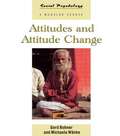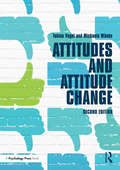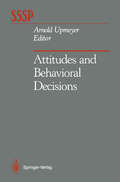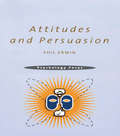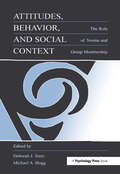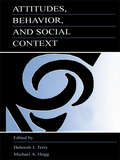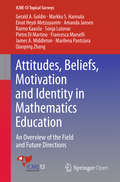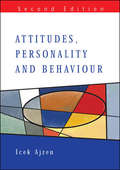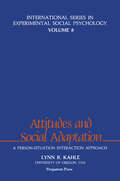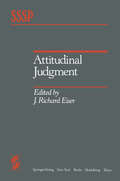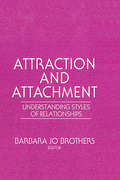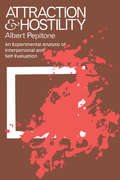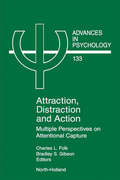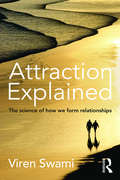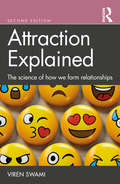- Table View
- List View
Attitudes And Attitude Change (Social Psychology A Modular Ser.)
by Gerd Bohner Michaela Wänke Tobias VogelAttitudes - cognitive representations of our evaluation of ourselves, other people, things, actions, events, ideas - and attitude change have been a central concern in social psychology since the discipline began. People can - and do - have attitudes on an infinite range of things but what are attitudes, how do we form them and how can they be modified? This book provides the student with a comprehensive and accessible introduction to the basic issues in the psychological study of attitudes. Drawing on research from Europe and the USA it presents up-to-date coverage of the key issues that will be encountered in this area, including attitude formation and change, functions of attitudes, attitude measurement, attitudes as temporary constructs, persuasion processes and prediction of behaviour from attitudes.
Attitudes and Attitude Change
by Tobias Vogel Michaela WankeAttitudes have been a central topic in social psychology from its early beginnings. But what exactly are attitudes, where do they come from, and how can they be modified? The overall aim of Attitudes and Attitude Change is to provide students with a comprehensive and accessible introduction to these basic issues in the psychological study of attitudes. In four parts, readers learn about how attitudes can be measured, how attitudes are shaped in the course of life, how they are changed by other people, and finally, how attitudes in turn affect our thoughts and behavior. This completely revised and updated second edition covers many recent developments and reports cutting-edge research while also addressing the classic findings and theories that advanced the field. In addition to integrating the newly emerged topics of implicit attitudes and recent models regarding the coexistence of explicit and implicit attitudes, this edition also adds chapters on social influence and resistance to persuasion. This comprehensive and user-friendly book carefully balances theoretical underpinnings and empirical findings with applied examples to enable readers to use the insights of attitude research for practical applications. Critical discussions also instigate readers to develop their own thinking on key topics.
Attitudes and Attitude Change (Social Psychology A Modular Ser.)
by Tobias Vogel Michaela WankeAttitudes have been a central topic in social psychology from its early beginnings. But what exactly are attitudes, where do they come from, and how can they be modified? The overall aim of Attitudes and Attitude Change is to provide students with a comprehensive and accessible introduction to these basic issues in the psychological study of attitudes. In four parts, readers learn about how attitudes can be measured, how attitudes are shaped in the course of life, how they are changed by other people, and finally, how attitudes in turn affect our thoughts and behavior. This completely revised and updated second edition covers many recent developments and reports cutting-edge research while also addressing the classic findings and theories that advanced the field. In addition to integrating the newly emerged topics of implicit attitudes and recent models regarding the coexistence of explicit and implicit attitudes, this edition also adds chapters on social influence and resistance to persuasion. This comprehensive and user-friendly book carefully balances theoretical underpinnings and empirical findings with applied examples to enable readers to use the insights of attitude research for practical applications. Critical discussions also instigate readers to develop their own thinking on key topics.
Attitudes and Behavioral Decisions (Springer Series in Social Psychology)
by Peter PearsonThis book summarizes theoretical and empirical work that was performed in a large-scale, cross-university research project on the relationship between attitudes and behavior. The entire program has been funded by the Deutsche Forschungsgemeinschaft (DFG), an institution that operates similarly to the American National Science Foundation. In 1981 the DFGruled to release the project for a five-year period with the option to extend if th~ extension proposal would suggest a major alteration of research goals. The participants are presently in the stage of transition between the first five-year allotment and the granted extension. We feel that this is the most opportune time to summarize the development of the project for an international audience. Until now only scattered publications have existed. This book is more than just a compilation of previously published results. Rather, it is the original contributions and a substantial share of newly published empirical results that guarantee an up-to-date exposition of the entire program. The general goal of the research group is to perform basic research in attaining explanations for the relationships between attitude and behavior and to improve the predictability of current predictor models. In pursuing this goal we are not primarily interested in the immediate strategy of redefining predictor variables within the framework of the general linear statistical model. Rather, we emphasize cognitive processes and structures that predispose a person's behavior, that accompany behavior, or that change as a result of prior behavior.
Attitudes and Decisions (Psychology Revivals)
by J Richard Eiser Joop van der PligtThe concept of attitude has long been a central part of social psychological theories. It is important in other disciplines too, such as economics, business studies, politics and sociology. Originally published in 1988, the authors of this text show how attitudes and motives are crucial in human decision-making, and explore the relationship between them. They look closely at the real context of people’s attitudes and behaviour, pointing out that attitudes are both a social product and an intrinsic part of social action. The authors show that theories of judgment, attitudes, attribution and decision-making can make important contributions to social issues such as the employment of nuclear energy, the storage of nuclear waste, health behaviour and medical decision-making. They emphasize that social psychology is relevant to a wide variety of social issues, deriving from the theoretical and distinctive methods that social psychology has developed.
Attitudes and Decisions (Psychology Revivals)
by J Richard Eiser Joop van der PligtThe concept of attitude has long been a central part of social psychological theories. It is important in other disciplines too, such as economics, business studies, politics and sociology. Originally published in 1988, the authors of this text show how attitudes and motives are crucial in human decision-making, and explore the relationship between them. They look closely at the real context of people’s attitudes and behaviour, pointing out that attitudes are both a social product and an intrinsic part of social action. The authors show that theories of judgment, attitudes, attribution and decision-making can make important contributions to social issues such as the employment of nuclear energy, the storage of nuclear waste, health behaviour and medical decision-making. They emphasize that social psychology is relevant to a wide variety of social issues, deriving from the theoretical and distinctive methods that social psychology has developed.
Attitudes and Persuasion
by Philip ErwinAttitudes and Persuasion provides an up-to-date overview of the crucial role that attitudes play in our everyday lives and how our thoughts and behaviour are influenced. The nature, function and origins of attitudes are examined, and a review of how they can be measured is given. The book addresses complex questions such as whether we always behave in accordance with our attitudes and what factors may influence us to change them.
Attitudes and Persuasion
by Philip ErwinAttitudes and Persuasion provides an up-to-date overview of the crucial role that attitudes play in our everyday lives and how our thoughts and behaviour are influenced. The nature, function and origins of attitudes are examined, and a review of how they can be measured is given. The book addresses complex questions such as whether we always behave in accordance with our attitudes and what factors may influence us to change them.
Attitudes, Behavior, and Social Context: The Role of Norms and Group Membership (Applied Social Research Series)
by Deborah J. Terry Michael A. HoggThe reasons why people do not always act in accord with their attitudes has been the focus of much social psychological research, as have the factors that account for why people change their attitudes and are persuaded by such influences as the media. There is strong support for the view that attitude-behavior consistency and persuasion cannot be well understood without reference to the wider social context in which we live. Although attitudes are held by individuals, they are social products to the extent that they are influenced by social norms and the expectations of others. This book brings together an international group of researchers discussing private and public selves and their interaction through attitudes and behavior. The effects of the social context on attitude-behavior relations and persuasion is the central theme of this book, which--in its combination of theoretical exposition, critique, and empirical research--should be of interest to both basic and applied social psychologists.
Attitudes, Behavior, and Social Context: The Role of Norms and Group Membership (Applied Social Research Series)
by Deborah J. Terry Michael A. HoggThe reasons why people do not always act in accord with their attitudes has been the focus of much social psychological research, as have the factors that account for why people change their attitudes and are persuaded by such influences as the media. There is strong support for the view that attitude-behavior consistency and persuasion cannot be well understood without reference to the wider social context in which we live. Although attitudes are held by individuals, they are social products to the extent that they are influenced by social norms and the expectations of others. This book brings together an international group of researchers discussing private and public selves and their interaction through attitudes and behavior. The effects of the social context on attitude-behavior relations and persuasion is the central theme of this book, which--in its combination of theoretical exposition, critique, and empirical research--should be of interest to both basic and applied social psychologists.
Attitudes, Beliefs, Motivation and Identity in Mathematics Education: An Overview of the Field and Future Directions (ICME-13 Topical Surveys)
by Markku S. Hannula Pietro Di Martino Marilena Pantziara Qiaoping Zhang Francesca Morselli Einat Heyd-Metzuyanim Sonja Lutovac Raimo Kaasila James A. Middleton Amanda Jansen Gerald A GoldinThis book records the state of the art in research on mathematics-related affect. It discusses the concepts and theories of mathematics-related affect along the lines of three dimensions. The first dimension identifies three broad categories of affect: motivation, emotions, and beliefs. The book contains one chapter on motivation, including discussions on how emotions and beliefs relate to motivation. There are two chapters that focus on beliefs and a chapter on attitude which cross-cuts through all these categories. The second dimension covers a rapidly fluctuating state to a more stable trait. All chapters in the book focus on trait-type affect and the chapter on motivation discusses both these dimensions. The third dimension regards the three main levels of theorizing: physiological (embodied), psychological (individual) and social. All chapters reflect that mathematics-related affect has mainly been studied using psychological theories.
Attitudes, Personality and Behaviour (UK Higher Education OUP Psychology Psychology)
by I AjzenWhy do people say one thing and do another? Why do people behave inconsistently from one situation to another?How do people translate their beliefs and feelings into actions? This thoroughly revised and updated edition describes why and how beliefs, attitudes and personality traits influence human behaviour. Building on the strengths of the previous edition, it covers recent developments in existing theories and details new theoretical approaches to the attitude-behaviour relationships. These novel developments provide insight into the predictability – and unpredictability – of human behaviour.The book examines:Recent innovations in the assessment of attitudes and personalityThe implications for prediction of behaviour of these innovationsDifferences between spontaneous and reasoned processesThe most recent research on the relations between intentions and behaviourWhile the book is written primarily for students and researchers in social, personality, and organizational psychology, it also has wide-reaching appeal to students, researchers and professionals in the fields of health and social welfare, marketing and consumer behaviour.
Attitudes & Social Adaptation: A Person-Situation Interaction Approach (International Series in Experimental Social Psychology #Volume 8)
by L. R. KahleAn important and interesting work which demonstrates the person-situation interaction theory of attitudes and attributes and shows how many of the principles of interaction or attribute research apply to attitude research (and vice versa). A new theory, social adaptation, is presented which attempts to account for the importance of attitudes and social cognition in human social behaviour, and applies Piaget's work on cognitive development to attitude research.
Attitudes to Psychological Stress Among Construction Professionals
by Alan PatchingThis book investigates attitudes to the avoidance and management of stress by project managers within the professional construction industry. The author argues that a widespread toxic culture belonging to the industry substantially contributes to industry stress, and analyses stress impacts among construction professionals, as well as the industry-specific causes of stress. The impacts and causes of stress of construction project managers are compared with those of other employees in the construction industry and with attitudes from across broader industry. The author concludes by establishing a leadership model for government and private organisations to effectively address a construction industry systemic problem head on.
Attitudinal Judgment (Springer Series in Social Psychology)
by J. RichardEiserDespite the central place that the study of attitudes has long held in social psycho logical research, the last decade or so has been relatively quiet as far as the de velopment of attitude theory has been concerned. If one looks back to the Yale studies on communication and persuasion in the 1950s, followed by the massive literature derived from cognitive dissonance theory and its alternatives, there may be a temptation to think that the well of researchable questions has run almost dry. The purpose of this book is to convince the reader that this is not the case. On the contrary, a new look at the concept of attitude offers the prospect of as rich and varied a range of questions as ever before. The term "new look" is an old one in social psychology. It was used 30 to 40 years ago as the designation for the school of thought which held that "basic" psychological processes such as perception, cognition, learning, and memory could be influenced by attitudes, motives, and values. There are still lessons to be learned from that period, and the new "new look" that is now emerging incorporates some of these same themes, albeit in the context of changing issues and emphases.
Attracted to Conflict: Dynamic Foundations of Destructive Social Relations (Peace Psychology Book Series)
by Robin R. Vallacher Peter T. Coleman Andrzej Nowak Lan Bui-Wrzosinska Larry Liebovitch Katharina Kugler Andrea BartoliConflict is inherent in virtually every aspect of human relations, from sport to parliamentary democracy, from fashion in the arts to paradigmatic challenges in the sciences, and from economic activity to intimate relationships. Yet, it can become among the most serious social problems humans face when it loses its constructive features and becomes protracted over time with no obvious means of resolution. This book addresses the subject of intractable social conflict from a new vantage point. Here, these types of conflict represent self-organizing phenomena, emerging quite naturally from the ongoing dynamics in human interaction at any scale—from the interpersonal to the international. Using the universal language and computational framework of nonlinear dynamical systems theory in combination with recent insights from social psychology, intractable conflict is understood as a system locked in special attractor states that constrain the thoughts and actions of the parties to the conflict. The emergence and maintenance of attractors for conflict can be described by means of formal models that incorporate the results of computer simulations, experiments, field research, and archival analyses. Multi-disciplinary research reflecting these approaches provides encouraging support for the dynamical systems perspective. Importantly, this text presents new views on conflict resolution. In contrast to traditional approaches that tend to focus on basic, short-lived cause-effect relations, the dynamical perspective emphasizes the temporal patterns and potential for emergence in destructive relations. Attractor deconstruction entails restoring complexity to a conflict scenario by isolating elements or changing the feedback loops among them. The creation of a latent attractor trades on the tendency toward multi-stability in dynamical systems and entails the consolidation of incongruent (positive) elements into a coherent structure. In the bifurcation scenario, factors are identified that can change the number and types of attractors in a conflict scenario. The implementation of these strategies may hold the key to unlocking intractable conflict, creating the potential for constructive social relations.
Attraction and Attachment: Understanding Styles of Relationships
by Barbara Jo BrothersHere is a fascinating exploration of the powerful forces of attachment and attraction that determine the formation and styles of couples’relationships. What factors attract one person to another? What determines whether or not a healthy relationship is formed? As therapists know, there is much in this world that passes for love but is really the result of leftover dependency needs and unresolved attachment issues. Attraction and Attachment: Understanding Styles of Relationships examines issues of attachment in relationships, discusses the validity of the concept of codependency as one aspect of attachment, and explores various aspects of attraction.The contributing authors consider some of the many styles of relationships that are called love and examine some of the basic sources of attraction. Attraction and Attachment includes an in-depth evaluation of the concept of codependency, a review of the literature on attraction, methods for achieving equilibrium in sexual intimacy, and some of Virginia Satir’s insights on fear and making changes. Just a few of the specific topics explored in these important chapters include: the relationship of childhood attachment experiences and successful long-term marriages the influence of therapists’implicit philosophies on treatment options and their effectiveness in therapy a review of biological, psychological, and social psychological literature on mate selection a definition of codependency a study of the link between codependency and depression couples’acceptance of alternative treatment formatsPsychiatrists, psychologists, and clinical social workers, as well as substance abuse counselors and pastoral counselors, can discover new insights on attraction and attachment in this provocative book. All mental health professionals can find new ways of looking at the foundational elements of relationships that are invaluable to them in their work with couples.
Attraction and Attachment: Understanding Styles of Relationships
by Barbara Jo BrothersHere is a fascinating exploration of the powerful forces of attachment and attraction that determine the formation and styles of couples’relationships. What factors attract one person to another? What determines whether or not a healthy relationship is formed? As therapists know, there is much in this world that passes for love but is really the result of leftover dependency needs and unresolved attachment issues. Attraction and Attachment: Understanding Styles of Relationships examines issues of attachment in relationships, discusses the validity of the concept of codependency as one aspect of attachment, and explores various aspects of attraction.The contributing authors consider some of the many styles of relationships that are called love and examine some of the basic sources of attraction. Attraction and Attachment includes an in-depth evaluation of the concept of codependency, a review of the literature on attraction, methods for achieving equilibrium in sexual intimacy, and some of Virginia Satir’s insights on fear and making changes. Just a few of the specific topics explored in these important chapters include: the relationship of childhood attachment experiences and successful long-term marriages the influence of therapists’implicit philosophies on treatment options and their effectiveness in therapy a review of biological, psychological, and social psychological literature on mate selection a definition of codependency a study of the link between codependency and depression couples’acceptance of alternative treatment formatsPsychiatrists, psychologists, and clinical social workers, as well as substance abuse counselors and pastoral counselors, can discover new insights on attraction and attachment in this provocative book. All mental health professionals can find new ways of looking at the foundational elements of relationships that are invaluable to them in their work with couples.
Attraction and Hostility: An Experimental Analysis of Interpersonal and Self Evaluation
by Anton PelinkaAttraction and hostility find expression in almost every variety of human relationship, and have consequently provided a central theme for social psychology since its beginnings. Yet attempts to conceptualize the diverse phenomena embraced in these terms have produced theories of such wide generality that they have little explanatory or predictive force. The object of the present study is to bring precision to a vast and sprawling area by setting limits and dimensions to the phenomena and investigating them experimentally on the basis of a series of hypotheses derived from a critical analysis of current conceptual approaches, including frustration, need-satisfaction, and dissonance models.The programme of experimental studies focuses on cognitive validation-a motivation to form and maintain subjectively valid evaluations of the self and the social environment-which is shown to be a common denominator of a number of attraction and hostility measures. The results throw light on reactions to boastfulness and to self-debasement; impressions of persons who are described by biased informants; effects of self-evaluation on competitiveness, and the projection of unfavourable characteristics.The interest of the study for social psychologists derives both from its theoretical integration of a wide range of behaviour and from its contribution to experimental design.
Attraction and Hostility: An Experimental Analysis of Interpersonal and Self Evaluation
by Albert PepitoneAttraction and hostility find expression in almost every variety of human relationship, and have consequently provided a central theme for social psychology since its beginnings. Yet attempts to conceptualize the diverse phenomena embraced in these terms have produced theories of such wide generality that they have little explanatory or predictive force. The object of the present study is to bring precision to a vast and sprawling area by setting limits and dimensions to the phenomena and investigating them experimentally on the basis of a series of hypotheses derived from a critical analysis of current conceptual approaches, including frustration, need-satisfaction, and dissonance models.The programme of experimental studies focuses on cognitive validation-a motivation to form and maintain subjectively valid evaluations of the self and the social environment-which is shown to be a common denominator of a number of attraction and hostility measures. The results throw light on reactions to boastfulness and to self-debasement; impressions of persons who are described by biased informants; effects of self-evaluation on competitiveness, and the projection of unfavourable characteristics.The interest of the study for social psychologists derives both from its theoretical integration of a wide range of behaviour and from its contribution to experimental design.
Attraction, Distraction and Action: Multiple Perspectives on Attentional Capture (ISSN #Volume 133)
by Charles Folk Bradley GibsonOver the last decade there has been a spate of research on the empirical phenomenon known as "attentional capture". Interest in capture can be attributed not only to its applied significance, but also to the implications of the phenomenon for theories of selective attention, as well as cognitive control in general. This growing interest, however, has also spawned a wide variety of experimental paradigms, empirical results, and theoretical perspectives. In June of 2000, 40 experimental psychologists converged on Villanova University for a conference and workshop on attentional capture. The intent was to provide an intimate forum for scientists from diverse perspectives and backgrounds, and using diverse methodologies to present their research on attentional capture and also engage in small group discussions on such key issues as the definition, measurement, and theoretical treatment of attention capture. This book presents a collection of chapters based on those presentations and discussions. Chapters are organized around areas such as neuroscience, visual cognition, developmental, individual differences and dynamical systems. The volume provides: a summary of the latest cutting edge research; an important compass for future research in this area; a useful survey of the field; contributions from internationally recognized experts in attention. Due to its exclusive focus on the topic of attentional capture the volume should make an excellent supplemental text or reference book for advanced undergraduate or graduate seminars in cognitive psychology and attention.
Attraction Explained: The science of how we form relationships
by Viren SwamiHow much does appearance matter in the formation of romantic relationships? Do nice guys always finish last? Does playing hard-to-get ever work? What really makes for a good chat-up line? When it comes to relationships, there’s no shortage of advice from self-help ‘experts’, pick-up artists, and glossy magazines. But modern-day myths of attraction often have no basis in fact or – worse – are rooted in little more than misogyny. In Attraction Explained, psychologist Viren Swami debunks these myths and draws on cutting-edge research to provide a ground-breaking and evidence-based account of relationship formation. At the core of this book is a very simple idea: there are no ‘laws of attraction’, no foolproof methods or strategies for getting someone to date you. But this isn’t to say that there’s nothing to be gained from studying attraction. Based on science rather than self-help clichés, Attraction Explained looks at how factors such as geography, appearance, personality, and similarity affect who we fall for and why.
Attraction Explained: The science of how we form relationships
by Viren SwamiWhen it comes to relationships, there’s no shortage of advice from self-help ‘experts’, pick-up artists, and glossy magazines. But modern-day myths of attraction often have no basis in fact or – worse – are rooted in little more than misogyny. Based on science rather than self-help clichés, psychologist Viren Swami debunks these myths and draws on cutting-edge research to provide a ground-breaking and evidence-based account of relationship formation. At the core of this book is a very simple idea: there are no ‘laws of attraction’, no fool-proof methods or strategies for getting someone to date you. But this isn’t to say that there’s nothing to be gained from studying attraction. Based on science rather than self-help clichés, Attraction Explained looks at how factors such as geography, physical appearance, reciprocity, and similarity affect who we fall for and why. With updated statistics, this second edition also includes new content on online dating, queer relationships, racism in dating, shyness, and individual differences. It remains an engaging and accessible introduction to attraction relationship formation for professionals, students, and general readers.
Attraction Explained: The science of how we form relationships
by Viren SwamiWhen it comes to relationships, there’s no shortage of advice from self-help ‘experts’, pick-up artists, and glossy magazines. But modern-day myths of attraction often have no basis in fact or – worse – are rooted in little more than misogyny. Based on science rather than self-help clichés, psychologist Viren Swami debunks these myths and draws on cutting-edge research to provide a ground-breaking and evidence-based account of relationship formation. At the core of this book is a very simple idea: there are no ‘laws of attraction’, no fool-proof methods or strategies for getting someone to date you. But this isn’t to say that there’s nothing to be gained from studying attraction. Based on science rather than self-help clichés, Attraction Explained looks at how factors such as geography, physical appearance, reciprocity, and similarity affect who we fall for and why. With updated statistics, this second edition also includes new content on online dating, queer relationships, racism in dating, shyness, and individual differences. It remains an engaging and accessible introduction to attraction relationship formation for professionals, students, and general readers.
Attraction Explained: The science of how we form relationships
by Viren SwamiHow much does appearance matter in the formation of romantic relationships? Do nice guys always finish last? Does playing hard-to-get ever work? What really makes for a good chat-up line? When it comes to relationships, there’s no shortage of advice from self-help ‘experts’, pick-up artists, and glossy magazines. But modern-day myths of attraction often have no basis in fact or – worse – are rooted in little more than misogyny. In Attraction Explained, psychologist Viren Swami debunks these myths and draws on cutting-edge research to provide a ground-breaking and evidence-based account of relationship formation. At the core of this book is a very simple idea: there are no ‘laws of attraction’, no foolproof methods or strategies for getting someone to date you. But this isn’t to say that there’s nothing to be gained from studying attraction. Based on science rather than self-help clichés, Attraction Explained looks at how factors such as geography, appearance, personality, and similarity affect who we fall for and why.
